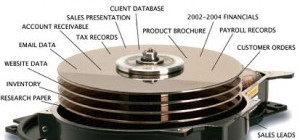 Studies on data security breaches are flat out alarming. The latest statistics show that the “average” data breach can cost a company nearly $4 million, with each stolen document being worth almost $150. And those numbers aren’t going down any time soon. Every single data breach incident costs not only money but time as well. The increase in attacks and data breach incidents makes choosing a data storage system that can protect your data a matter of stomach-knotting importance. If protecting your business with a data storage system keeps you up at night, here are three things you need to look for to get the right one:
Studies on data security breaches are flat out alarming. The latest statistics show that the “average” data breach can cost a company nearly $4 million, with each stolen document being worth almost $150. And those numbers aren’t going down any time soon. Every single data breach incident costs not only money but time as well. The increase in attacks and data breach incidents makes choosing a data storage system that can protect your data a matter of stomach-knotting importance. If protecting your business with a data storage system keeps you up at night, here are three things you need to look for to get the right one:
1. Data Storage System Security: Basic Essentials
If your company is in the market for a data storage system that meets the highest security standards, it’s essential to verify that the developers of any system you investigate, employ their very own “hackers” to constantly stress-test for potential vulnerabilities. In addition to the human element, system developers need to use a code-scanning toolset that verifies security from the opposite direction. This will ensure that the system holds true against the constantly-changing world of malcontents with their malware.
Anydata storage securitysystem you choose should be automatically updated at the firm-level, on a regular, ongoing basis, to address any newly-discovered threats and vulnerabilities in real time. The right system will also employ walls of secure socket layers and constantly evolving anti-virus, anti-malware, and anti-intrusion scans that guard your data against bad actors and their tools.
Additional aspects of a high-security data storage system will include elements such as multi-factor password authentication, electronic signatures, single-sign-on, and the ability to configure stringent password setup requirements for authorized users within your company. That way, documents are secure internally and externally, giving decision-makers secure control over the lifecycle of each document within the system. Again, the best data storage security system will continue to evolve and automatically update with the latest security measures to protect against threats as they develop. In other words — data storage security is really “never done,” and any package you decide on should come with a guarantee that your system will update and evolve regularly.
2. Key Benefit: Secure Data Storage Makes Auditing Easier
When you find a data storage security system with all of these layers of protection, it removes several huge headaches from your business processes. One of the key burdens it relieves is auditing time – it makes it much more manageable. A secure document management system will enable you to do everything from digitizing paper legacy documentation to using a simple search-engine like feature that empowers you to type in the name, date, or other tags for any document you need within the system. Again, authorization controls will ensure that only those employees with specific permission have access to any set of documents, even though the search feature should be incredibly easy to use.
Two key benefits emerge from this sort of secure data storage system during audit season. First, audit preparation and data collection time decreases from a matter of days to minutes. Second, accuracy improves because the digitization of legacy documents enables authorized users to verify the data stored within the documents quickly, and the system removes the potential of keyboarding mistakes.
3. Improved Data Management Within a Secure Environment
A robust data storage and document management system that resides in a very stable, secure environment should provide a host of other benefits as well – one being the ability to gather key insights from a wide range of documents housed within it. Decision makers will have the power to manage a document’s entire lifecycle from beginning to end. They will even be able to set permissions for who is allowed to change, view, and print documentation within the organization. This increases the level of document security even further than just protecting mission-critical data from outside threats.
These extra security and document management layers protect your data from within and from without. They provide a high level of granular document control that prevents accidental breaches and leaks, while empowering decision makers to monitor the documentation process from creation, through execution, and on to completion.







